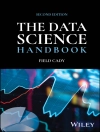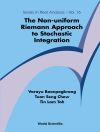Provides authoritative guidance on statistical analysis techniques and inferential methods for one-shot device life-testing
Estimating the reliability of one-shot devices—electro-expolsive devices, fire extinguishers, automobile airbags, and other units that perform their function only once—poses unique analytical challenges to conventional approaches. Due to how one-shot devices are censored, their precise failure times cannot be obtained from testing. The condition of a one-shot device can only be recorded at a specific inspection time, resulting in a lack of lifetime data collected in life-tests.
Accelerated Life Testing of One-shot Devices: Data Collection and Analysis addresses the fundamental issues of statistical modeling based on data collected from accelerated life-tests of one-shot devices. The authors provide inferential methods and procedures for planning accelerated life-tests, and describe advanced statistical techniques to help reliability practitioners overcome estimation problems in the real world. Topics covered include likelihood inference, competing-risks models, one-shot devices with dependent components, model selection, and more. Enabling readers to apply the techniques to their own lifetime data and arrive at the most accurate inference possible, this practical resource:
- Provides expert guidance on comprehensive data analysis of one-shot devices under accelerated life-tests
- Discusses how to design experiments for data collection from efficient accelerated life-tests while conforming to budget constraints
- Helps readers develops optimal designs for constant-stress and step-stress accelerated life-tests, mainstream life-tests commonly used in reliability practice
- Includes R code in each chapter for readers to use in their own analyses of one-shot device testing data
- Features numerous case studies and practical examples throughout
- Highlights important issues, problems, and future research directions in reliability theory and practice
Accelerated Life Testing of One-shot Devices: Data Collection and Analysis is essential reading for graduate students, researchers, and engineers working on accelerated life testing data analysis.
Jadual kandungan
Preface xi
About the Companion Website xiii
1 One-Shot Device Testing Data 1
1.1 Brief Overview 1
1.2 One-Shot Devices 1
1.3 Accelerated Life-Tests 3
1.4 Examples in Reliability and Survival Studies 4
1.4.1 Electro-Explosive Devices Data 4
1.4.2 Glass Capacitors Data 5
1.4.3 Solder Joints Data 5
1.4.4 Grease-Based Magnetorheological Fluids Data 6
1.4.5 Mice Tumor Toxicological Data 7
1.4.6 ED01 Experiment Data 7
1.4.7 Serial Sacrifice Data 7
1.5 Recent Developments in One-Shot Device Testing Analysis 10
2 Likelihood Inference 13
2.1 Brief Overview 13
2.2 Under CSALTs and Different Lifetime Distributions 13
2.3 EM-Algorithm 14
2.3.1 Exponential Distribution 16
2.3.2 Gamma Distribution 18
2.3.3 Weibull Distribution 21
2.4 Interval Estimation 26
2.4.1 Asymptotic Confidence Intervals 26
2.4.2 Approximate Confidence Intervals 28
2.5 Simulation Studies 30
2.6 Case Studies with R Codes 41
3 Bayesian Inference 47
3.1 Brief Overview 47
3.2 Bayesian Framework 47
3.3 Choice of Priors 49
3.3.1 Laplace Prior 49
3.3.2 Normal Prior 49
3.3.3 Beta Prior 50
3.4 Simulation Studies 51
3.5 Case Study with R Codes 59
4 Model Mis-Specification Analysis and Model Selection 65
4.1 Brief Overview 65
4.2 Model Mis-Specification Analysis 65
4.3 Model Selection 66
4.3.1 Akaike Information Criterion 66
4.3.2 Bayesian Information Criterion 67
4.3.3 Distance-Based Test Statistic 68
4.3.4 Parametric Bootstrap Procedure for Testing Goodness-of-Fit 70
4.4 Simulation Studies 70
4.5 Case Study with R Codes 76
5 Robust Inference 79
5.1 Brief Overview 79
5.2 Weighted Minimum Density Power Divergence Estimators 79
5.3 Asymptotic Distributions 81
5.4 Robust Wald-type Tests 82
5.5 Influence Function 83
5.6 Simulation Studies 85
5.7 Case Study with R Codes 91
6 Semi-Parametric Models and Inference 95
6.1 Brief Overview 95
6.2 Proportional Hazards Models 95
6.3 Likelihood Inference 97
6.4 Test of Proportional Hazard Rates 99
6.5 Simulation Studies 100
6.6 Case Studies with R Codes 102
7 Optimal Design of Tests 105
7.1 Brief Overview 105
7.2 Optimal Design of CSALTs 105
7.3 Optimal Design with Budget Constraints 106
7.3.1 Subject to Specified Budget and Termination Time 107
7.3.2 Subject to Standard Deviation and Termination Time 107
7.4 Case Studies with R Codes 108
7.5 Sensitivity of Optimal Designs 113
8 Design of Simple Step-Stress Accelerated Life-Tests 119
8.1 Brief Overview 119
8.2 One-Shot Device Testing Data Under Simple SSALTs 119
8.3 Asymptotic Variance 121
8.3.1 Exponential Distribution 121
8.3.2 Weibull Distribution 122
8.3.3 With a Known Shape Parameter ????2 124
8.3.4 With a Known Parameter About Stress Level ????1 125
8.4 Optimal Design of Simple SSALT 126
8.5 Case Studies with R Codes 128
8.5.1 SSALT for Exponential Distribution 128
8.5.2 SSALT for Weibull Distribution 131
9 Competing-Risks Models 141
9.1 Brief Overview 141
9.2 One-Shot Device Testing Data with Competing Risks 141
9.3 Likelihood Estimation for Exponential Distribution 143
9.3.1 Without Masked Failure Modes 144
9.3.2 With Masked Failure Modes 147
9.4 Likelihood Estimation for Weibull Distribution 149
9.5 Bayesian Estimation 155
9.5.1 Without Masked Failure Modes 155
9.5.2 Laplace Prior 156
9.5.3 Normal Prior 157
9.5.4 Dirichlet Prior 157
9.5.5 With Masked Failure Modes 158
9.6 Simulation Studies 159
9.7 Case Study with R Codes 165
10 One-Shot Devices with Dependent Components 173
10.1 Brief Overview 173
10.2 Test Data with Dependent Components 173
10.3 Copula Models 174
10.3.1 Family of Archimedean Copulas 175
10.3.2 Gumbel–Hougaard Copula 176
10.3.3 Frank Copula 177
10.4 Estimation of Dependence 180
10.5 Simulation Studies 181
10.6 Case Study with R Codes 184
11 Conclusions and Future Directions 187
11.1 Brief Overview 187
11.2 Concluding Remarks 187
11.2.1 Large Sample Sizes for Flexible Models 187
11.2.2 Accurate Estimation 188
11.2.3 Good Designs Before Data Analysis 188
11.3 Future Directions 189
11.3.1 Weibull Lifetime Distribution with Threshold Parameter 189
11.3.2 Frailty Models 189
11.3.3 Optimal Design of SSALTs with Multiple Stress Levels 189
11.3.4 Comparison of CSALTs and SSALTs 190
Appendix A Derivation of Hi (a, b) 191
Appendix B Observed Information Matrix 193
Appendix C Non-Identifiable Parameters for SSALTs Under Weibull Distribution 197
Appendix D Optimal Design Under Weibull Distributions with Fixed ????1 199
Appendix E Conditional Expectations for Competing Risks Model Under Exponential Distribution 201
Appendix F Kendall’s Tau for Frank Copula 205
Bibliography 207
Author Index 217
Subject Index 221
Mengenai Pengarang
NARAYANASWAMY BALAKRISHNAN, Ph D, is Distinguished University Professor, Department of Mathematics and Statistics, Mc Master University, Hamilton, Ontario, Canada.
MAN HO LING, Ph D, is Associate Professor, Department of Mathematics and Information Technology, The Education University of Hong Kong, Hong Kong SAR, China.
HON YIU SO is Post-Doctoral Fellow, University of Waterloo, Waterloo, Ontario, Canada.












